Hiii,
It is no secret that hexagons are everywhere these days, but that doesn't make them any less awesome. Here are some of my favorite hexagon pictures from out there in blogland:
(I know that this one came from www.redpepperquilts.com, one of my absolute favorite blogs)
I will consider this task practice for making the hexagon / honeycomb quilt on my Bucket List. I found various methods from a few different tutorials work best for me. To make the hexagons, I loosely followed a hexagon tutorial from Amy Gunson. I mainly used page 7 of her pdf for the correct sized cut-outs. See my process below:
1) First, I bought a hexagon template for rotary cutting my fabric. See template below:
(Found at Joann's for $16.99 (but only $10.20 with a 40% off coupon))
3) Then I picked out some fabric scraps to cut up and pressed them flat. Note that to make a 2 inch finished hexagon, you need fabric that is at least 2.5 inches square (to account for a 1/4 seam allowance on all sides of the hex). See the fabric scraps I picked out:
3) After you have your fabrics all picked out, cut your scraps into 2.5 inch strips like below and press:
(2.5 inch strips are all pressed and ready to go)
4) Then, using the hexagon tool, cut out the hexagon in 2 steps, both show below:
- STEP 1: Starting at the left side of the strip, line up the corner of the 2.5 inch hexagon template with the edge of the strip and, using a rotary cutter, cut along the right side of the hexagon template:
(a closer look)
(an even closer look)
(Cut along the right side of the template)
(finished step #1)
- STEP 2: <Please forgive the bad pictures> Flip around the template with the cutting edge towards the left end of the fabric strip. Make sure to align the already cut corner in step 1 with the 2.5 inch corner of the template. Then, once everything is in line, rotary cut the left edge of the hexagon.
(aligning the fabric with the template)
(a finished cut hexagon)
(continue to work across the strip with step 1)
(and again with step 2)
5) YAY! Now you have the fabric for your hexagon:
(YAYAY! Repeat with all your cut strips and you should have a few hexagons)
6) Now, using the template from Amy @ Badskirt, print out a few copies of page 7 (it has all the paper hexagons that measure 2 inches). It is recommended to use card stock, but I can't print on card stock from my home printer, so I just used regular printing paper:
7) Cut out all of the paper hexagons:
8) Start lining up the paper hexagon with your fabric hexagon. Now, you can see that the paper hexagons are about 1/4 inch smaller than your fabric. Match up your paper hexagons with your fabric hexagons by aligning the paper hexagon in the middle of the wrong side of the fabric. I affix a hair clip to hold the two together temporarily, it really helps with making a more accurate hex:
9) Now it's time for basting your hexagons.
- Using a needle and thread with a knot at the end (thread color doesn't matter at all), start on the edge directly left of the clip and fold the fabric edge over the paper (I find that it helps a little to press the folded edge with your fingers)
- Insert your needle into and out of the FABRIC ONLY, not the paper template. You will NEVER insert your needle into the PAPER or the FRONT OF THE HEXAGON.
- Move counter-clockwise around the hexagon, folding over the edges and basting the fabric at the corners. I find it easiest to baste at the corner fold nearest to the center, not the edge, it gives me the best corners.
(Baste the fabric in EACH CORNER)
- When you get to the last 2 corners, remove the clip and continue to baste:
(Removing the clip)
(Clip is gone)
(Continue to fold last 2 corners)
(Baste last corner)
(Cut the thread)
(Tie a knot to secure the basting)
(A finished hexagon!)
(This one turned out better than the green one, so I wanted to show you that it gets better with practice)
(A bunch of finished hexagons)
10) After your hexagon is basted, take it to the ironing board and start pressing the heck out of those seams. I wouldn't recommend using steam because it might distort your paper hexagon (if you intend on using it again). I literally just set the iron on the hex for a while and prayed that it didn't burn.
(Firmly pressed hexagons)
11) After you've got a bunch of little hexagons pressed beyond belief, it is time to decide how you will design whatever you are making. Below are common hexagon pattern arrangements:
(flower arrangement consists of 1 center hexagon with six hexes surrounding the center)
(Diamond arrangement with hexagons consists of 1 center hexagon with 8 hexagons surrounding it and built up further from there)
(A completely random but wicked fun arrangement)
12) Now that you've picked out your arrangement (I will be doing the hexagon flower), play around with your fabric layout:
(This is the arrangement I chose to go with)
13) Once your layout is determined, you can start sewing them together (Sew with RIGHT SIDES facing one another). There are two stitches that can be used. You can use the whip stitch or the ladder stitch. See page 3 of Amy's hexagon tutorial detailed illustrations of the 2 stitches. She does a very good job of showing you how to make the stitches, so I am not going to reiterate, I just want to show you the end result of each stitch. See my pictures below of the two stitches. I don't love either stitch really, here is my take on them:
- Whip Stitch: A very quick stitch. I find that with the whip stitch is too loose and the thread shows on the front of the hexagon. However, this allows the hexagon to lay perfectly flat after being stitch together with other hexagons. So it bothers me that the thread shows.
(If you look closely at the seems, you can see that the thread shows and that really bothers me)
- Ladder Stitch: This stitch takes a little longer. I also find that the ladder stitch is a tighter stitch but leaves a weird effect on the front of the hexagon that doesn't allow it to lay perfectly flat. It bothers me that it doesn't lay as flat at the whip stitch.
(A close up)
(Notice that there are no little threads showing, I like that, but you can see that there almost look like indents because of the stitching)
(No little threads showing)
14) Now that the hexagon is all stitched up, take it over the to ironing board and press the life out of it:
(Hexagon flower all pressed)
15) I haven't made hexagon arrangements larger than one of the flowers, but after you are done with your entire arrangement, that is when you take out the papers. To be honest, I am not sure what the rule is on taking out the basting threads. They are invisible from the front, so I guess if you wanted to leave them in for more stability, I can't see that being a problem. Whichever you choose to do, make sure to take out the PAPER FIRST so your basting threads help to not distort the hex. I am going to leave my basting threads on this time. I guess my method is pushing the paper out from the front of the flower.
(No more papers!)
16) I would definitely go give the hex another press after you remove all of the papers.
17) Then, I would trim up all those loose ends. I think it's safe to say that you can trim them pretty close to the knot you made
(No more loose ends!)
18) Then I would press them again, it can't hurt, right? AND DONE!
(YESSSSSSSSSSSSS!)
OK! All that work for some hexagons? Yup. Let me know if you have any questions at all or if I can add anything to the semi-tutorial to make it any more helpful if you are using it as a guide.
Happy Crafting. So much for the typical Wordless Wednesday post that most bloggers do. Maybe next week.

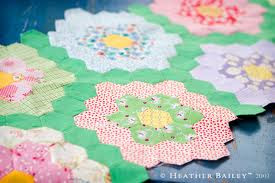












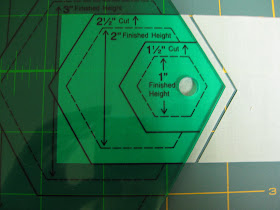















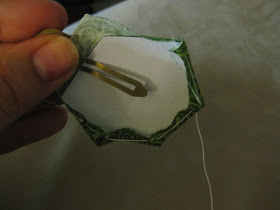

















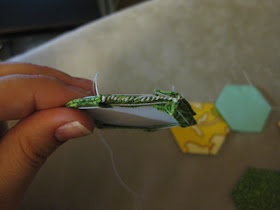






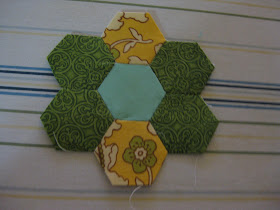





Thanks for the great tutorial! I'm just starting my first hexagon quilt and looking for lots of good how to info!
ReplyDeleteI love how detailed this tutorial is!
ReplyDelete